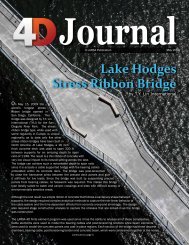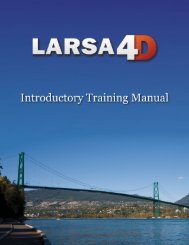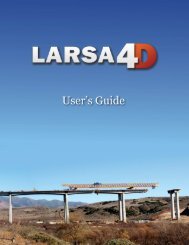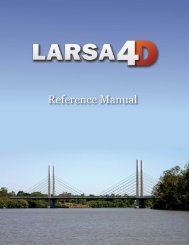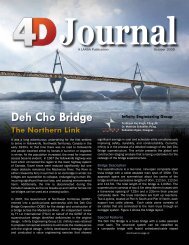LARSA 4D Introductory Training Manual for Bridge ... - LARSA, Inc.
LARSA 4D Introductory Training Manual for Bridge ... - LARSA, Inc.
LARSA 4D Introductory Training Manual for Bridge ... - LARSA, Inc.
- No tags were found...
You also want an ePaper? Increase the reach of your titles
YUMPU automatically turns print PDFs into web optimized ePapers that Google loves.
<strong>LARSA</strong> <strong>4D</strong> <strong>Introductory</strong> <strong>Training</strong> <strong>Manual</strong> <strong>for</strong> <strong>Bridge</strong> Projects<br />
Vehicle and UDL Setup<br />
The influence analysis in <strong>LARSA</strong> <strong>4D</strong> was developed with AASHTO LRFD and AASHTO LFD in mind,<br />
although the influence solver can be used <strong>for</strong> many design specifications. We will use AASHTO LRFD<br />
in this example.<br />
In the AASHTO LRFD code, a lane is loaded with combinations of a Design Tandem, Design Truck,<br />
and a Design Lane Load. <strong>LARSA</strong> <strong>4D</strong>’s standard load pattern database consists of the following two<br />
load patterns suitable <strong>for</strong> this code:<br />
• HL-93 Design Truck in con<strong>for</strong>mance with AASHTO LRFD 3.6.1.2.2. This truck has three axles<br />
of 8, 32, and 32 kips spaced (a minimum of) 14 ft. apart. The spacing between the two 32 kip<br />
axles may vary between 14 ft. and 30 ft. to produce extreme <strong>for</strong>ce effects. (Loads are lumped<br />
on the centerline of the lane, so no transverse effects are considered.<br />
• HL-93 Design Tandem in con<strong>for</strong>mance with AASHTO LRFD 3.6.1.2.3. The design tandem<br />
consists of a pair of 25 kip axles spaced 4 ft. apart.<br />
The uni<strong>for</strong>m load (UDL) is specified separately from the vehicle type.<br />
We first must load into the project the vehicle definitions from a database of vehicles provided with<br />
<strong>LARSA</strong> <strong>4D</strong>.<br />
Go to Input Data → Connect Databases and choose Connect Standard Database .<br />
Open the file “AASHTO Vehicle Patterns.dml”. Then click OK .<br />
Connecting the AASHTO LRFD Load Patterns Database<br />
Each lane will be configured separately. For each lane, we will create an Influence Line result case<br />
which specifies how to per<strong>for</strong>m AASHTO LRFD live load.<br />
Click Results → Influence Line/Surface Case to start configuring a new influence-based result<br />
case.<br />
Make sure that “Influence Line Coefficients Right Lane” is chosen at the top.<br />
All of the default options on the first tab are correct. Note that Load <strong>for</strong> Extreme Force Effects is<br />
turned on.<br />
Click Vehicular Loading .<br />
Click Add Lane Type . Then click the Select Vehicle Pattern entry in the list on the left.<br />
On the right, where it reads (Select Pattern) , click it and choose HL-93/HS20-44 Design Truck.<br />
26



